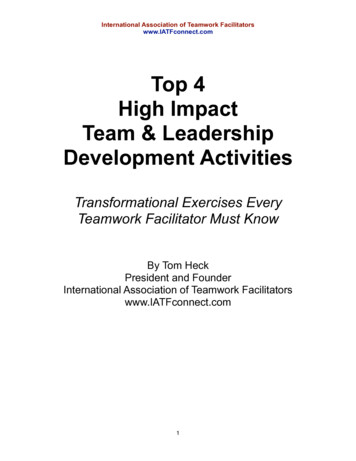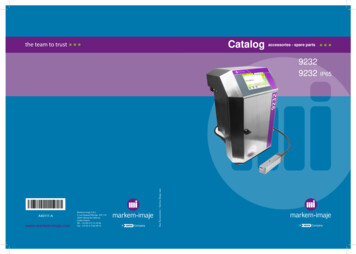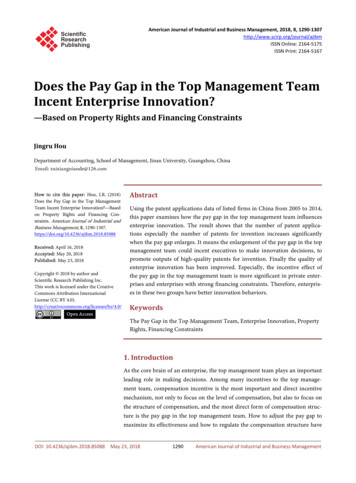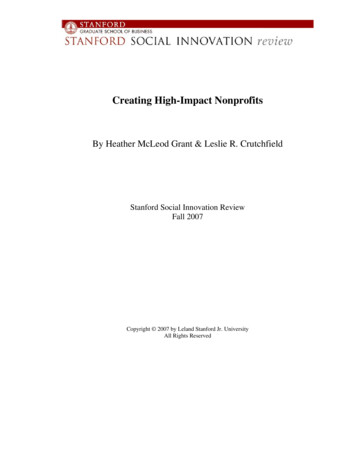
Transcription
International Association of Teamwork Facilitatorswww.IATFconnect.comTop 4High ImpactTeam & LeadershipDevelopment ActivitiesTransformational Exercises EveryTeamwork Facilitator Must KnowBy Tom HeckPresident and FounderInternational Association of Teamwork Facilitatorswww.IATFconnect.com1
International Association of Teamwork Facilitatorswww.IATFconnect.comThe International Association of Teamwork Facilitators (IATF) is a membershiporganization which supports the work of Teamwork Facilitators and Coaches around theworld. Benefits include: Access to our community of practitioners to ask questions, offer support,share ideas, and network Monthly Leadership Development TeleSeminars Monthly Training Calls with IATF visiting faculty on cutting-edge subjects fromthe field of Team and Leadership Development Access to an online Audio Archive of interviews with leaders in the industry Monthly Group Coaching/Q & A Calls Access to a growing Virtual Library of Teambuilding ExercisesOne of the tools commonly used by Teamwork Facilitators is experiential learningexercises (aka teambuilding games). When facilitated well, this type of learningexperience can produce learning “shifts” that are both deep and profound.The four activities in this e-book are “high impact” in that they have been found toconsistently produce the kind of learning opportunities that help teams move from goodto great.A Leadership NoteLead these activities in such a manner that the participants understand they havechoice as to the degree to which they participate. Encourage each person tocommunicate their comfort level with the activity and to join in at the level they choose(full, partial, none) rather than be coerced into participation.To get the most out of the experience, facilitate a discussion with the group afterwards.Suggestions for starting a conversation (debriefing / processing) are offered in each2
International Association of Teamwork Facilitatorswww.IATFconnect.comdescription. The key to learning through experiential teambuilding exercises is thecombination of activity PLUS discussion.Challenge and adventure activities can present elements of physical and emotional risk.The information presented in this activity guide is for your reference, and you areultimately responsible for judging the suitability of an activity and safely supervising theactivity.The publisher of this document assumes no responsibility or liability for the use of theinformation presented in this guide. This includes errors due to misprinting or omissionof detail.No single source of adventure-based experiential education can substitute for practicalexperience and education. While this activity guide serves as an introduction to the useof experiential learning exercises, it is only an introduction. Studying the material in thisactivity guide is no substitute for professional training. You can receive professionaltraining and development through the IATF.Enjoy!Tom HeckPresident & FounderInternational Association of Teamwork Facilitatorswww.IATFconnect.com3
International Association of Teamwork Facilitatorswww.IATFconnect.comActivity # 1Mouse Trap TrustGroup Size: People work in pairsAge Range: AdultIntensity: Mental 3, Physical 1Time: 20 – 30 minutesSpace: Minimal – Medium -- LotsSet Up Time: 3 minutesProps: One “traditional” wooden mousetrap per pairObjectiveCoach your partner (who’s eyes are closed) into placing their hand on top of aset mousetrap.Skills DevelopedCommunication, Trust, Planning, Coaching4
International Association of Teamwork Facilitatorswww.IATFconnect.comSet Up / Preparation1. This is an advanced activity to be led by a skilled facilitator with groups that areready for the challenge.2. Prior to leading this activity you must accurately assess your group’s ability tosafely participate in this activity. Do not attempt this activity if your or your groupisn’t ready.3. Make sure your group understands that participation in this activity is purelyvoluntary. If you don’t want to participate than don’t do it. Find some other wayto add value to the experience (observe and give feedback, etc.).4. When you’re group is clear on the rules of engagement tell them there will befour stages to this activity:The Four Stages (Steps)Step #1Leader demonstrates how to set a mousetrap.Partner up, each pair gets 1 mousetrap, practice settingthe trap.Plan on this taking about 4-5 minutesStep #2Partners each get a chance to set a trap with their eyesclosed.Plan on this taking about 4-5 minutesStep #3Show the group how to safely un-set a trap by placingyour hand directly on top of the trap and then taking yourhand off the trap.This step can be a shocker for some. They might find ithard to believe what you’re doing.Plan on this taking about 5 minutes to have pairs try.Step #4Person A closes eyes then person B sets trap and placesit on a hard surface.Person A is coached by person B to un-set trap.Switch roles. Pacing is important. Don’t rush this activity. Speak clearly and confidently. This is not the time and place for jokes (by youor anyone else). Don’t show all 4 steps at one time. Show one step then have the group dothat step.5
International Association of Teamwork Facilitatorswww.IATFconnect.comSafety WarningA high degree of trust is required to successfully accomplish this challenge. Thischallenge is best left for a group that is advanced as far as maturity and theirability to safely care for one another. People can get hurt in this activity but it isunlikely they will get seriously hurt (that’s one reason we use a mouse trapinstead of a rat trap!).Facilitator Notes This is one of the most amazing activities I’ve ever seen. It’s so portable andyet so powerful in it’s ability to create growth possibilities within individualsand a group. If you are familiar with the trust building activity called the Trust Fall(described in the online archive of teambuilding games at the InternationalAssociation of Teamwork Facilitators) you’ll find this activity to be similar in it’simpact. Expect some people not to participate in this activity at all. Expect others tostop participating half way through (like when you tell them to put their handon top of the trap). This activity can be powerful with a small group (two or four people) and justas powerful with a room full of people (500 ). I’d even go so far to say thatthis activity will be transformational for many.Debriefing Suggestions Which did you prefer, to coach or be coached? Why? If this mousetrap represents a fear in your life, what did you like about howyou handled it? What would you change? What did you observe in the interactions between partnerships around you?6
International Association of Teamwork Facilitatorswww.IATFconnect.comVariationsHand out a mousetrap to each person. Have them write on the trap a fear theyare choosing to face in their life.HistoryThis activity comes from the brilliant mind of Sam Sikes who has authoredseveral teambuilding games books. www.doingworks.comInternational Association of Teamwork FacilitatorsMembership Benefit # 1Monthly Leadership Development TeleSeminars -- learn the best streetsmart strategies, tactics and tools for building and leading teams usinga “coach approach”.www.IATFconnect.com7
International Association of Teamwork Facilitatorswww.IATFconnect.comActivity # 2MinefieldGroup Size: 2 – 50Age Range: elementary – adultIntensity: Mental 2 or 3, Physical 1Time: 15 – 30 minutes (without debrief)Space: Minimal – Medium -- LotsSet Up Time: 5 minutesProps: 70 feet of rope or tape to create a playing area, 50 – 100 objects that act asobstacles/landmines (ex. Tennis balls, pieces of foam, mousetraps, etc.)Game ObjectiveTravel through the minefield with the help of your partner.Skills DevelopedTrust, Communication, Planning8
International Association of Teamwork Facilitatorswww.IATFconnect.comSet Up / Preparation1. Create the playing area. For a group size of 12 people start by creating a 10 ft x10 ft square on the ground out of rope or tape (larger groups need a larger sizeplaying area). On the “start” and “finish” sides of the box create “doors” using 6inch long strips of tape - - these short pieces of tape need to be two feet apart(refer to diagram below).STARTDoorsEND2. Create obstacles (land mines) in the playing area by filling the square (playingarea) with tennis balls or pieces of paper, etc. The more obstacles you add theharder the game will be. Adding approximately 30 obstacles into the square willprovide a medium level of difficulty for most groups. Spread out the obstacles insuch a way that their are no straight pathways through the minefield.NOTE: During the actual activity, you may find the group has located an easypathway which you did not see until the game has started. I allow myself theoption to change/adjust the minefield playing area midstream by rearrangingthe obstacles. If the group challenges me on this I usually say I’m attemptingto mimic real life in that things change and you can either adapt or complain.Presenting the Challenge1. Have everyone find a partner and stand on the “start” side of the square playingarea.9
International Association of Teamwork Facilitatorswww.IATFconnect.com2. Presentation Script: “Your challenge is to travel through the playing area to theother side of the square. You’ll be working in teams of two. At the beginning ofthe game everyone will start behind the line on the “start” side of the square.Teams of two (partners) can work independently of other teams. When travelingthrough the playing area (minefield) your eyes must be closed which means yourpartner must coach you / guide you (verbally) through the minefield helping youavoid the obstacles (land mines). When the first person in your partnershipmakes it to the other side he/she can open his/her eyes and the rolls switch - now that person becomes the coach and guides his/her partner (verbally)through the playing area from the start side to the end side.” [read the rulesbelow]Rules1. No running or fast moving.2. People must stand behind the start line or the end line or be walking through theplaying area (minefield). No one is allowed on the sides of the playing area.3. Anyone inside the playing area must have their eyes closed.4. Multiple people can be inside the playing area.5. You must enter and exit through one of the “doors”.6. If anyone touches a land mine or the perimeter of the playing area, they mustreturn to the start side and try again.7. The participants may not alter the playing area but the facilitator can.8. Violation of a rule may result in a penalty.Safety Warning1. The playing area must be safe because people will be walking around with theireyes closed. Make sure the playing area is level and flat.2. If someone needs to open their eyes to feel safe that’s fine.10
International Association of Teamwork Facilitatorswww.IATFconnect.comFacilitator Notes1. If you have an uneven number of people just create one team of 3 (Person A,Person B, Person C). Person A goes through the playing area first then coachesPerson B through who coaches Person C through.2. I’ve led this activity effectively with groups as small as 4 people and as large as80. The great thing about this activity is people work in pairs and can besomewhat independent of the other people.3. When the activity is in full motion, there is lots of talking and things can get loud(larger groups get louder). With large groups it can feel somewhat chaotic(mostly because of the noise) because multiple teams are workingsimultaneously.4. This is a wonderful activity to practice coaching (coaching others and beingcoached). Every moment of this activity provides ample opportunity to practiceclear and precise communication.5. Once the first person makes it to the other side he/she will typically only coachhis/her partner through. However, that same person may choose guide peopleother than his/her partner. I’ve deliberately provided rules that allow teams/people to collaborate.Debriefing SuggestionsLand mines (obstacles) are metaphoric problems the group faces either personallyor as a team. They are everywhere in life (personal & public). Some land mines arebig and some are small - - they all do damage when we hit them. In this exercise,there are lots of land mines separating the participants from their desired outcomes(goals).Life is full of obstacles. Some people allow obstacles to prevent them fromsucceeding. Others keep running into the obstacles. What are the obstacles in yourlife (in your team) that you must recognize and then avoid?We can go through life trying to avoid the obstacles but it’s easier when we havehelp. Where do you get help in real life? Are you effective at asking for help? How11
International Association of Teamwork Facilitatorswww.IATFconnect.comare you at receiving help? How do you know? Are you good at giving help? Howdo you know?Variations1. Provide the team with a time limitation. For example, the team has 20 minutes toget the entire team from one side to the other.2. At the beginning of the activity before the group actually starts (but after you’vesupplied the instructions), warn them that a “communication breakdown” mayoccur during the activity. If this happens, people will not be allowed tocommunicate verbally. Don’t tell them how long it will last (make it last no morethan 60 seconds). This will allow people to plan (or not) for this possibility.3. Provide each person with one index card and have everyone write down anattribute they bring to the team on their card. These cards will then be scattered(writing side down) throughout the playing area (inside the square) among theobstacles. During the game each person is to pick up ONE card while travelingthrough the playing area (while remaining sightless) and carry it to the other side.The metaphor here is that everyone brings talents and skills to the team and yetwe must work together to bring forth and utilize these talents.4. Divide the team in half. Group A will start on one side of the playing area andGroup B will start on the other side of the playing area. Follow the basic set ofrules with this one twist - - Group A must move to where Group B is and Group Bmust move to where Group A is (teams moving in opposite directions). Makesure people in Group A partner up with each other and people in Group B partnerup with each other. Hopefully the two groups will realize that the game runsbetter if they collaborate.5. In the basic setup of this game I provide two “doors” - - one at the start and oneat the end of the playing area. For larger groups you may need to not only createa larger playing area (square) you may need to add more doors.6. To take this activity to an entirely new level use mousetraps in the minefield andhave participants walk through with bare feet.12
International Association of Teamwork Facilitatorswww.IATFconnect.comHistoryThis teambuilding game was described by Karl Rohnke in his famous book“Quicksilver” published in 1995. www.karlrohnke.comRelated Quote“Faith means living with uncertainty - feeling your way through life, letting your heartguide you like a lantern in the dark” Dan MillmanInternational Association of Teamwork FacilitatorsMembership Benefit # 2Immediate access to our growing community of practitioners to askquestions, offer support, share ideas, and network.www.IATFconnect.com13
International Association of Teamwork Facilitatorswww.IATFconnect.comActivity # 3Helium StickGroup Size: 8 – 20Age Range: high school – adultIntensity: Mental 3 , Physical 1Time: 20 - 60 minutes (longer is more realistic)Space: Minimal – Medium -- LotsSet Up Time: 60 secondsProps: Helium Stick (aluminum tent pole)ObjectiveLower the aluminum tent pole to the ground.Skills DevelopedProblem Solving, Planning, Communication, Focus14
International Association of Teamwork Facilitatorswww.IATFconnect.comSet Up / Preparation1. Divide your group in half and then have them create two parallel lines where thelines are facing each other. The lines are close to each other (approximately 12– 18 inches apart). The members of each line stand shoulder to shoulder.2. Once the two lines are formed, everyone holds out their index fingers at waistlevel.3. You (the facilitator) then announce to the group that you will be placing analuminum tent pole on top of their fingers. THIS PART IS IMPORTANT - - whenyou place the tent pole on their fingers, do so from behind and in the middle ofone of the lines ALWAYS KEEPING YOUR HAND ON TOP OF THE TENT POLEto prevent the group from raising the pole in the air. Apply enough pressure ontop of the pole to prevent the group from lifting it up. It seems every group I’veworked with wants to raise the tent pole with their fingers even before theyunderstand or know the directions.4. Finally, with your hand on top of the tent pole (the helium stick), you will givethem the following directions: “Your directions are as follows as a group, youmust lower this tent pole to the ground without even a single person on the teamlosing contact with the tent pole. Should someone lose contact with the tent poleyou must start again.” Then, release your hand from the tent pole. ‘Rules1. No one may lose contact with the tent pole. If anyone loses contact with the tentpole the entire group must start again. The starting position is with the tent poleat waist level.2. Both index fingers must be used and only the index fingers may be used. Theindex fingers must be placed below the tent pole. Nothing else is allowed totouch the tent pole (other than the ground at the end of the activity).Safety WarningThe ends of the tent pole can be dangerous if the pole starts moving quickly andhits someone in the face. Take precautions to prevent injury.15
International Association of Teamwork Facilitatorswww.IATFconnect.comFacilitator Notes1. This is a VERY CHALLENGING activity. Do not do this with groups in seriousconflict.2. Here’s what typically happens in this activity: When you (the facilitator) give thedirections and then release the pole, the group will often times RAISE the pole(not lower it)! The group will usually laugh and find this somewhat strange. Itslikely to take several attempts to just keep the tent pole steady (not lowering orraising).3. This is a communication intensive activity where each person must be absolutelycommitted to doing his or her part. People will likely get frustrated and it’scommon for some blaming to occur.4. The group will likely throw out many ideas on how to solve this challenge. Whatit usually comes down to is the entire group focusing, doing their job with thedirection of one leader. Groups that have the most difficulty are usually all talkingat once.5. You may have to stop this activity several times mid-stream to help the groupprocess how they are approaching this activity.Debriefing SuggestionsI’ve successfully used this activity to help the leadership of an organizationrealize that having a company mission is one thing and making it a reality isanother. I did this by leading the group in a four-hour company vision statementworkshop. After everyone was in agreement about the vision statement andunderstood it I had the group do the Helium Stick activity. Here is the metaphor Ishared with the group: The tent pole was the company vision and bysuccessfully lowering it to the ground they achieved their vision. What happenednext was eye opening! The tent pole immediately went in the OPPOSITEdirection from where they were trying to go – UP! After 50 minutes of trying tolower the tent pole to the ground they succeeded. In the debrief I asked thegroup if they experienced any parallels to real life while doing this activity. YESthey said everyone had to be committed to the process, blaming and excusesdidn’t make things better, staying calm and focused was critical, and so on.16
International Association of Teamwork Facilitatorswww.IATFconnect.comVariationsHave people pair up and supply each pair with a very short tent pole (18 inches).Have each pair lower their own pole to the ground so they can experiencesuccess. Then have people form groups of 4 and then provide them with a tentpole just long enough for 4 people. Have the groups of 4 work together to lowerthe pole. Continue making bigger groups until you have everyone workingtogether on one tent pole.HistoryI was taught this game by master teambuilder Viva Pizer.Related Quote"Float like a butterfly, sting like a bee." Muhammad AliInternational Association of Teamwork FacilitatorsMembership Benefit # 3Immediate access to a growing Virtual Library of TeambuildingExercises. Watch video clips of the games in action and print lead-ityourself directions.www.IATFconnect.com17
International Association of Teamwork Facilitatorswww.IATFconnect.comActivity # 4Caterpillar TraverseGroup Size: 4 – 12Age Range: high school – adultIntensity:Mental: easy. .hardPhysical: easy. .hardTime: 20 – 40 minutes (without debrief)Space: minimal. .lotsSet Up Time: 5 minutesAmount of Duct Tape Required: 40 - 50 feetGame ObjectiveWith ankles taped, the team travels as a unit from Point A to Point B.18
International Association of Teamwork Facilitatorswww.IATFconnect.comSkills DevelopedClear Communication, Trust, Planning, Patience, Goal Setting and Achievement,Resource ManagementSet Up / Preparation1. Tape two parallel lines (boundary lines) on the ground 9 - 10 feet apart.2. In between the parallel lines, tape three squares on the ground with sides of thesquares measuring approximately two feet. The squares can be placed in astraight line or in a zig-zag (see photo). The squares should be no more than 12inches apart from each other and the end squares no more than 12 inches fromthe parallel lines.3. Start by asking the group to stand behind one of the boundary lines.4. Have the team line up shoulder to shoulder (and ankle to ankle). Provide eachperson with a piece of tape long enough to tape feet (or ankles) together.Suggest participants reach down and tape their right foot (or ankle) to theirneighbor’s left foot (ankle). NOTE: Do not tape skin. Be aware that duct tapemay damage some types of shoes and clothing.Rules1. The boundary ropes and hoops may not be moved.2. The group must remain in a line with ankles tied throughout the activity.3. Stepping outside of the hoops while traveling to the rescue ship is not permitted.4. No other equipment may be used.5. Violation of a rule may result in a penalty. (Example: touches outside of thehoops will require the team to start over)Safety Warning1. People with knee, ankle or back injuries should not participate.2. Ankles should be taped together loosely to help reduce the likelihood of injuries.3. It’s important for the group to move slow so no one gets hurt.19
International Association of Teamwork Facilitatorswww.IATFconnect.com4. Do not allow people to put tape on bare skin because removing the tape willcause injury.Facilitator Notes1. This activity is best left for groups that are patient. Do not attempt this activitywith a rambunctious hyperactive group.2. The group movement will remind you of a centipede.3. This activity emphasizes communication, careful steady movement and teamcoordination.Debriefing SuggestionsPrior to starting the activity, have the group identify their current situation (spaceship)they are leaving behind - - metaphorically this ship represents all that they no longerneed and/or those things that no longer serve them. Also identify the newdestination (“rescue ship”) and it’s qualities. What do the squares on the groundrepresent? What does the tape around the ankles represent?Variations1. Supply the group with a limited amount of time to complete the task (example: 20minutes).2. Require two or three people to close their eyes for part or all of the activity.3. Divide the team in half. One group starts on one side and one group starts onthe other. The groups must switch places before time runs out. Will they worktogether or against each other?4. Do this activity in a room that you can turn the lights off so as to make itcompletely dark (facilitator has a flash light to look for rule violations). Warn thegroup that you might turn the lights off during the activity. If you do turn the lightsoff, keep them off for a short time (5 to 10 seconds).HistoryThis game was taught to me by an intern.20
International Association of Teamwork Facilitatorswww.IATFconnect.comInteresting Quote“What the caterpillar calls the end of the world, the master calls a butterfly.” Richard BachInternational Association of Teamwork FacilitatorsMembership Benefit # 4Monthly Group Coaching / Q&A Calls -- live support to get yourquestions answered and receive support from the best in the industry.Membership Benefit # 5Immediate access to an online Audio Archive of interviews with leadersin the industry.Membership Benefit # 6Monthly Training Calls with IATF visiting faculty on cutting-edgesubjects from the field of Team and Leadership Development.www.IATFconnect.com21
Challenge and adventure activities can present elements of physical and emotional risk. The information presented in this activity guide is for your reference, and you are . Monthly Leadership Development TeleSeminars -- learn the best street-smart strategie











